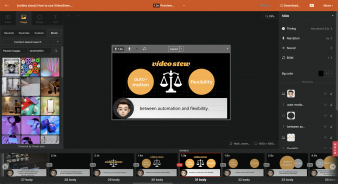
Junwoo
2024-08-27 12:38:59
Behind
UX Details to Make All TTS Engines Properly Read Korean
🤔
Create Advertisements with Videostew (Behind the Scenes)
I'd like to share my experience of creating an English version of an advertisement video for posting on the Videostew Global channel. 🎥✨Rather than a tutorial, ...

🤔
Finding the Balance Between AI and Creativity
Between Automation and CreativityOver the past year, Videostew has focused on perfecting the 'essential editing features' that any video editing solution should...

🤔
Defending Against DDoS with AWS WAF: Focusing on User Experience
Running a website inevitably means facing abnormal traffic attacks. Especially when aiming for global services, the domain itself becomes more exposed, increasi...

🤔
Developing a Global Version Website with GPT & Copilot
When developing a website, you might focus solely on your native language, but if you're offering a globally sellable SaaS service, something feels lacking. How...

🤔
UX Details to Make All TTS Engines Properly Read Korean
VideoStew offers a variety of AI voices. From Google Wavenet, Amazon Polly, KT AI Voice, Naver Clova, Azure, to ElevenLabs...As a result, a natural issue arises...

🤔
Practical GPT Utilization for Startup Marketers (We said GPT, but we only used Claude 😅)
Hello, this is Jun from VideoStew.Lately, I've been writing a lot of behind-the-scenes posts. In this post, I will summarize how I, as a non-developer at a star...

🤔
Videostew: Turn Your Message into Video, Just as You Envisioned
Hello, this is Jun from Videostew. Today, I'd like to share the story of how we created Videostew and why we chose to build it the way we did. You might call it...

🤔
The Struggles of a SaaS Startup with Viral Marketing through Open Chat
Getting StartedMost startups don't have a lot of money. Especially when it comes to marketing budgets! (Or they tend to be extra frugal.) Maybe that's why free ...

VideoStew offers a variety of AI voices. From Google Wavenet, Amazon Polly, KT AI Voice, Naver Clova, Azure, to ElevenLabs...
As a result, a natural issue arises: each model is trained differently, so even the same sentence is read slightly differently. This difference is particularly noticeable when reading units.
In this post, we’ll discuss the considerations we took into account to ensure proper reading of units in Korean when generating TTS.
Getting Measurement Units Right
When using various TTS engines, we encountered an issue where even the expression "100kg" was read differently by each engine. Some would read it as "hundred K-G," while others would trail off awkwardly at the end with "hundred krr..." (
Yes, even AI can get flustered...)Of course, there were engines that read it accurately as "hundred kilograms."
To address this, we developed a preprocessing library to standardize how these units are read across all engines.
Getting Numbers Right
Running this service, we encountered another unexpected issue. (Korean is truly a fascinating language..)
In Korean, there are two ways to read numbers, something we instinctively use but might not notice.
For instance, when telling time, "10시 10분" is read as "yeol si sip bun." Why...?
And while general numbers are read in Sino-Korean ("il, i, sam"), when a quantity unit is added, they are read in native Korean ("han gae, du gae, se gae"). Official measurement units use Sino-Korean. (e.g., 10cm = "sip sen-ti-mi-teo")
Alright, let me give you a number. “90”. How would you read it?
Technically, up to 90 should be read as “ninety.” Some of you might have read it as “nine zero.” As numbers get larger, we tend to adopt a more convenient way to read them.
Let’s think about smaller numbers. “9.” Yes, everyone would read this as “nine.”
Following this principle, we developed a preprocessing system that reads numbers from 1 to 99 in their unique word forms. However, this is just a guideline, and we’re open to changing it based on customer feedback. For instance, “forty” might feel more natural than “four zero.”
Anyway, to ensure a consistent user experience, we created a unit library corresponding to the unique word forms like “one, two, three.”
If you're looking to implement a TTS service, this library could be useful. However, keep in mind that it's not a complete version as we continuously discover unexpected units through customer feedback.
Detail in UX = Success in SaaS
Encountering the term “quantifier” for the first time, we faced many challenges while providing a video editing SaaS solution in Korea. It was yet another reminder of how dynamic and remarkable the Korean language is…
While we sometimes envy English-speaking services, they surely have their own set of challenges.
Of course, VideoStew offers a feature called [Manual Text Designation]. This allows you to generate TTS regardless of what's displayed on the screen.
< Setting the sound to be read by TTS regardless of the subtitles displayed on the screen >
By using this method, you can write as you like and as it sounds, leading TTS to pronounce more naturally and allowing users to correct any misread units directly.
The reason we focus on such details is our conviction that these small differences determine the growth of the service.
Users have a preconceived notion of how a sentence with numerical expressions should be read the moment they input it. If it doesn't generate as expected, that's an initial problem. Our ultimate UX goal is to produce the expected result as quickly as possible without additional editing.
We will continue to post our UX considerations like this in the future. As mentioned earlier, in the current situation where all services are leveling up, we believe that pondering over such details determines the success or failure of a service.